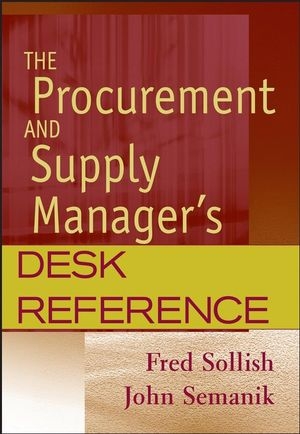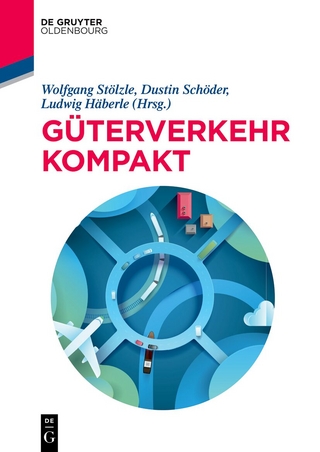
The Procurement and Supply Manager's Desk Reference
John Wiley & Sons Inc (Verlag)
978-0-471-79043-3 (ISBN)
- Titel erscheint in neuer Auflage
- Artikel merken
The Procurement and Supply Manager's Desk Reference "Finally, a cohesive volume written for the worldwide profession of purchasing and supply chain management." -James D. Reeds, CPM, CFPIM, CIRM, CPCM, President, Institute for Supply Management-Silicon Valley "Great resource. This work is educational, informative, and certainly, most practical." -Peter Sterlacci, Director, Professional Development, San Jose State University "Complete with useful information-the authors are extraordinary experts in the field of supply chain management." -Michael Geraghty, MBA, President, Geraghty International, and author of Anybody Can Negotiate-Even You! Destined to become every supply manager's essential desktop tool with in-depth, authoritative coverage of each topic Leaving no stone unturned in covering all aspects of the purchasing and sourcing function, The Procurement and Supply Manager's Desk Reference is filled with everything every supply manager needs to know about the key roles and responsibilities of a procurement manager.
Filled with practical aids such as checklists and customizable forms, this essential book provides an easy-to-use road map for the supply manager in the new millennium. With an eye toward incorporating proactive strategies and best practices, The Procurement and Supply Manager's Desk Reference offers detailed coverage and tips on:* Procurement and Best Business Practices* Sourcing Management* How to select suppliers and measure performance* The best way to leverage computer systems* Providing value to the organization* Identifying those strategies that will work best for your business for years to come
Fred Sollish, MS, CPM, is the Managing Director of eParagon, LLC, a consulting firm specializing in providing training and working tools for the supply chain management profession. Fred is former president and CEO of the Institute for Supply Management (ISM) Silicon Valley affiliate. He is an instructor and Program Coordinator for California State University, San Jose, and the Center for Intelligent Supply Networks at the University of Texas, Dallas. John Semanik, MBA, CPM, is cofounder and Director of eParagon, LLC. He has served in senior corporate supply chain positions at leading-edge companies such as Hewlett-Packard and Sun Microsystems, Inc. John is Vice President of the Institute for Supply Management (ISM) Silicon Valley affiliate. He is Managing Director and instructor for San Jose State University's Professional Development curriculum in Supply Chain Management and Purchasing.
Preface. Acknowledgements. CHAPTER1 PROCUREMENT AND BEST BUSINESS PRACTICES. 1.1 Understanding Procurement. 1.2 Understanding and Conveying Requirements. 1.3 Creating Strategic Plans and Tactics. 1.4 Finding Innovative Methods and Exploring Alternatives. 1.5 Providing Procurement Services. 1.6 Accepting Orders. 1.7 Placing Orders. 1.8 Mastering Procurement and Business Tactics. 1.9 Budgets and Expense Allocation. 1.10 Internal Control Systems. 1.11 Establishing Procurement Methods. 1.12 Internal Cost-Related Analysis Tools. 1.13 Keeping Supplier Information. 1.14 Summary. CHAPTER2 SOURCING MANAGEMENT. 2.1 Establishing Requirements. 2.2 Creating and Organizing Requirements. 2.3 Developing Specifications and Formats. 2.4 Specification Traps. 2.5 Locating and Developing Sources of Supply. 2.6 Types of Competition. 2.7 Locating Suitable Suppliers. 2.8 Determining Changing Marketplace Factors. 2.9 Obtaining Bids and Proposals. 2.10 Bidding Guidelines. 2.11 Formulating the Bid or Proposal Type. 2.12 Managing Sourcing Data. 2.13 Types of Sourcing. 2.14 Maintaining Sourcing Lists. 2.15 Regulatory Factors Governing Procurement. 2.16 Import/Export Issues. 2.17 Summary. CHAPTER3 SELECTING SUPPLIERS AND MEASURING PERFORMANCE. 3.1 Selecting the Supplier and Awarding the Contract. 3.2 Applying Selection Criteria. 3.3 Administering the Contract. 3.4 Summary. CHAPTER4 CONTRACT ADMINISTRATION. 4.1 Contract Essentials. 4.2 Reviewing Contracts for Legal Requirements. 4.3 Aligning Contracts and Practices with Policy. 4.4 Maintaining Procurement Documents and Records. 4.5 Summary. CHAPTER5 ADMINISTERING CONTRACTS FOR OPTIMUM SUPPLIER PERFORMANCE. 5.1 Managing Contract Compliance. 5.2 Tracking and Expediting Deliveries. 5.3 Handling Supplier-Related Deviations. 5.4 Summary. CHAPTER6 PROJECT MANAGEMENT. 6.1 The Five Project Management Processes. 6.2 Stage One: Initiating a Project. 6.3 Stage Two: Project Planning. 6.4 Stage Three: Project Execution. 6.5 Stage Four: Project Controlling. 6.6 Stage Five: Project Closeout. 6.7 A Key Knowledge Area: Project Procurement Management. 6.8 Summary. CHAPTER7 NEGOTIATIONS. 7.1 Assessing the Negotiating Environment. 7.2 Gathering Information and Analysis. 7.3 Preparing for the Negotiation. 7.4 Conducting the Negotiation. 7.5 Summary. CHAPTER8 LEVERAGING COMPUTER SYSTEMS. 8.1 Using Basic Information Technology Processes. 8.2 Using Software for Procurement. 8.3 Sourcing Supply Management Tools. 8.4 Summary. CHAPTER9 QUALITY. 9.1 Managing Quality Performance. 9.2 Ensuring Quality Performance. 9.3 Summary. CHAPTER 10 PROCUREMENT'S INTERNAL RELATIONSHIPS. 10.1 Understanding Key Departmental Roles. 10.2 Developing Good Working Relationships. 10.3 Participating in Cross-Functional Operations. 10.4 Reengineering Supply Management. 10.5 Summary. CHAPTER 11 SUPPLIER RELATIONSHIP MANAGEMENT. 11.1 Managing Productive Supplier Relationships. 11.2 Developing Continuous Improvement. 11.3 Pricing Factors and Supply. 11.4 Representing the Organization. 11.5 Summary. CHAPTER 12 FINANCIAL DECISIONS FOR SOURCING. 12.1 Performing Make-or-Buy Analysis. 12.2 Performing Lease-or-Buy Analysis. 12.3 Formulating Financial Strategies. 12.4 Summary. CHAPTER 13 MATERIAL MANAGEMENT AND SUPPLY OPERATIONS. 13.1 Inventory Control and Management Systems. 13.2 Physical Management and Inventory Accounting. 13.3 Disposition Surplus Assets. 13.4 Summary. CHAPTER 14 LOGISTICS. 14.1 The Logistics Process. 14.2 Modes of Transportation. 14.3 Traffic Management. 14.4 Customs. 14.5 Logistics in the Context of International Trade. 14.6 Government Organizations and Roles, Regulations, and Controls. 14.7 Supplemental Information. 14.8 Summary. 14.9 Links. CHAPTER 15 PROVIDING VALUE TO THE ORGANIZATION. 15.1 Standardizing Purchased Materials. 15.2 Improving Procurement-Related Processes. 15.3 Controlling and Reducing Cost. 15.4 Supporting New Product Introduction. 15.5 Summary. CHAPTER 16 STRATEGIC PLANNING FOR PROCUREMENT. 16.1 Developing Demand- and Forecast-Based Procurement Strategies. 16.2 Planning Procurement Requirements. 16.3 Conducting Market Analysis. 16.4 Summary. CHAPTER 17 THE PROCUREMENT ORGANIZATION. 17.1 Planning Procurement Strategies and Objectives. 17.2 Developing Departmental Goals and Objectives. 17.3 Formulating Operational Policies and Procedures. 17.4 Preparing Departmental Reports. 17.5 Responding to Audits. 17.6 Evaluating Procurement Department Performance. 17.7 Administering Departmental Budgets. 17.8 Budgeting Processes. 17.9 Working with Operational Forms. 17.10 Summary. CHAPTER 18 HUMAN RESOURCES FOR PROCUREMENT. 18.1 Leading the Supply Management Team. 18.2 Recruiting, Hiring, Promoting, and Terminating Employees. 18.3 Training for Professional Competence. 18.4 Job Performance. 18.5 Handling Employee Performance Issues. 18.6 Preventing Workplace Discrimination and Harassment. 18.7 Summary. APPENDIX A Sample Purchase Requisition Form. APPENDIX B Sample Purchase Order Form. APPENDIX C Electronic Catalog Example. APPENDIX D Common Auction Types. APPENDIX E Commonly Used Financial Ratios. APPENDIX F Request for Proposal (RFP) Example. APPENDIX G Request for Quotation Example. APPENDIX H Outline of Uniform Commercial Code and Article 2. APPENDIX I Important U.S. Import/Export Regulations. APPENDIX J Sample Terms and Conditions. APPENDIX K Links to Related Professional Organizations. Bibliography. Index.
| Verlagsort | New York |
|---|---|
| Sprache | englisch |
| Maße | 188 x 265 mm |
| Gewicht | 1058 g |
| Einbandart | gebunden |
| Themenwelt | Wirtschaft ► Betriebswirtschaft / Management ► Logistik / Produktion |
| ISBN-10 | 0-471-79043-5 / 0471790435 |
| ISBN-13 | 978-0-471-79043-3 / 9780471790433 |
| Zustand | Neuware |
| Haben Sie eine Frage zum Produkt? |
aus dem Bereich



